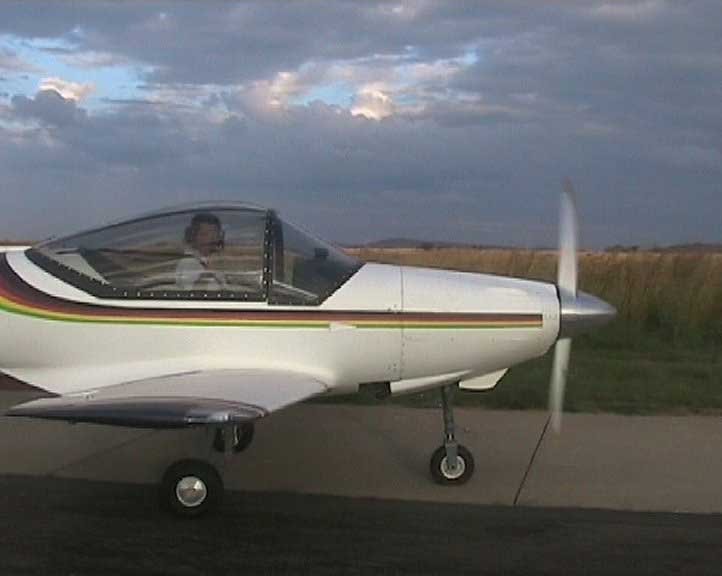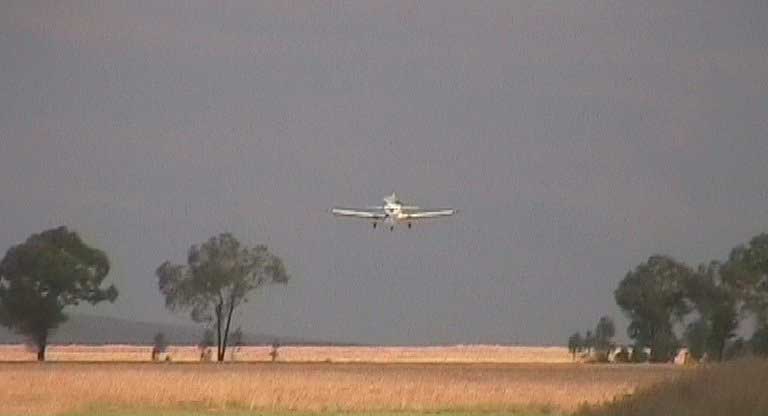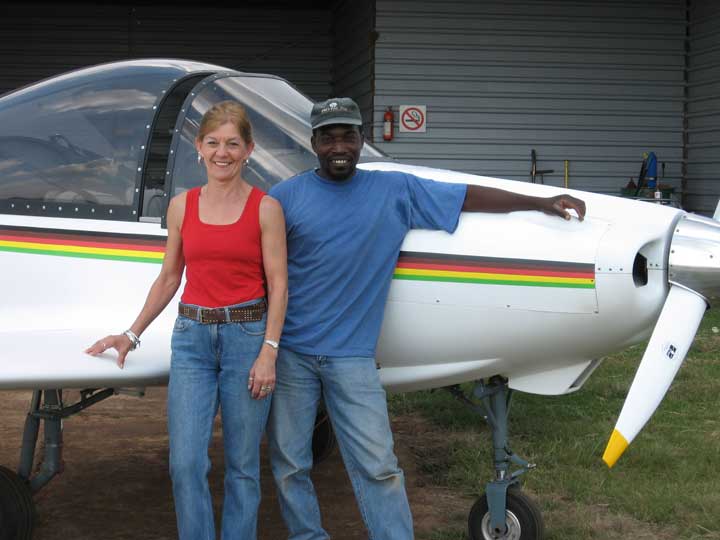Falco Out of Africa
![]()
Falco Out of Africa |
|

|
Instrument panel is simple. |
When I look back on the whole building process, I have to confess to not really knowing how I did it. Although South Africa led the world in some areas (heart transplants, banking systems, deep level mining), we only got television in 1976 (it was banned previously—even closed circuit video training facilities were few and far between) and many other systems ranging from telephones to government financial controls were antediluvian. Consequently, building a Falco with all the specified materials was next to impossible. We were not allowed to export money without an import permit and that was reserved almost exclusively for businesses. Many builders thus used to use any travel allowance surplus they might have to load suitcases with whatever could be carried.
Being a well qualified metallurgist helped me to assess substitute metallic materials and additionally I found that the local mining industry used large quantities of Douglas Fir which was stocked by large timber yards. This then was used in place of spruce, and I was extremely careful about dimensions because of the 17% weight penalty—also about 17% stronger. KR2 experience had revealed the availability of Araldite 2011—an excellent epoxy glue—so construction of the first elevator tip rib (“Barbara, come and see the Falco!”) was achieved quite quickly.
Progress was steady in spite of fairly frequent trips to France—I had become President of the Amateur-Built Aircraft Commission of the FAI—and local commitments (was also president of the EAA in South Africa) until 1992 when I was given the task of starting up a tyre-cord factory for the Haggie Group, my employer for 26 years. That task was carried out but I then decided to retire at the age of 52 in 1997. The next five years were taken up revelling in my retirement, and I had no time for anything! This is reflected in my builder’s log which shows that in the six years from March 1997 to March 2003, approximately 100 hours were entered.
During this whole process I had been in close contact with Fanie Hendricks and Koen Plantinga (two other Falco builders) and had helped with materials substitution as well as with machining of landing gear parts (carried out by my uncle whose lathes and milling equipment were bigger than mine). To give an idea of the difficulties we faced: our oleos were made from solid 114mm diameter 7075 bar! We used six lengths of that diameter to make our six oleos. Our gear legs were made from ST52 honed hydraulic tube which, because of its 5mm wall thickness, had to be machined to thinner sizes. Most, if not all of Fanie’s brackets and hinges were milled by him from solid material!

|
Brian Zeederberg taxies out |
After reading all the foregoing technical stuff, Barbara asked “what about the human element in all this?”
Of course, she is right. As a technical person, I wrote hundreds of technical reports during my career and, of necessity, they had to be dispassionate and objective. I find it extremely difficult to break out of that mould. Nevertheless a few anecdotes might be of interest, and I’ll try to be human!
George and Joy Barrett were kind enough to have me to their home on one of my trips, and I remember George informing me “It is impossible to form the leading edge of the plywood on the wing.” Now, while I work pretty hard, if there is any easier way of doing something, I’m all for it and building George’s leading edge forming jig was not part of the plan! (Fanie had done so, but it was too much like hard work.).
What did I do? I threw all the plywood sheets into the swimming pool for the week it took them to sink. Then you know they are wet. After stapling them in place on the wing, I stapled battens along the ply parallel to the leading edge and hung weights from the battens to cause the ply to take an initial bend around the leading edge. I then placed a one-inch perforated copper tube along the leading edge and connected it to a kettle with a garden hosepipe and boiled water in the kettle causing a substantial amount of steam to be projected onto the ply. In a matter of minutes the stuff bent like butter—does butter bend?—and I stapled the ply round the leading edge. After a week of drying and checking to ensure there was no delamination, the now beautifully formed ply was ready for gluing. I like a challenge!
Although I took 5000 hours to build this scratch-built Falco, Barbara asked how many cups of coffee and how many kilograms of biscuits she had to bring from the house to the workshop. Sadly this was not in my logbook. Barbara was also very concerned when she saw it assembled for the first time in the workshop. Forget all the accolades about Frati design, cruise speed, etc. She took one look at the ‘boot’ (trunk or luggage space) and declared “that’s not big enough. At my age there’s only enough space for my makeup!” So, of course, now I have to start the brain-washing about packing lightly and intelligently and explaining why she won’t be able to take three changes of clothing per day when we fly away somewhere.

|
First landing |
It seems that, especially over the last five years, Barbara’s adult art pupils have begun to feel very sorry for me. She is always immaculately dressed and made up, and I was always seen wearing a blue overall. It might even be the same one in which I was photographed for the picture placed on the Seqair website about 15 years ago! They concluded that I was sacrificing everything for her and that I did not own any other clothing. Needless to say I milk that for all it’s worth.
I’m not a publicity hound so it was Barbara who arranged for a reporter from our local community newspaper to come and take some pictures and ask some questions (like, seeing the dissembled Falco on the trailer ready to go to the airport “Will you be test flying it tomorrow?”). The whole event took 20 minutes so I had no expectations of article size or accuracy. Surprise! Accurate front page coverage which resulted in friends I had not seen in years calling to say hello. Bigger surprise! A friend called to say he had been eating some breakfast when suddenly he got indigestion—there I was, large as life in a national newspaper! Now I have to fend off the ‘publicity seeker’ comments.
Last year a friend, who has been building a Teenie Two, ’phoned to tell me that before I did any more spray painting I should check our Aviation Authority website because the regulations relating to registration letters had been changed and indeed the South African identification letters themselves has been changed.
I had just spent a week masking off all my letters and this news came on top of a stated intent by our authority to require all aircraft to have mode-C transponders fitted. I had been one of the opponents of this and was still steamed up about it so a very short fuse resulted in me expressing somewhat negative feelings about governments, aviation authorities and generally moronic politicians. Then he started laughing. It was April 1. Hook line and sinker!

|
Barbara and Witness Ndlovu |
Although he has never been in a position to become involved in the Falco construction, our gardener/househelp, Witness Ndlovu has always shown an interest and indeed he proudly took a copy of the newspaper article to his family in Zimbabwe when he went up there on holiday recently. He tends our half-acre garden very well, and I will take him in the Falco to see it from the air once I am permitted to fly it.
Although Barbara concentrated on her art in her studio while I was busy Falco-building, I was never alone, being constantly accompanied by Gypsey, our long haired Alsation. She has the most beautiful eyes and is an utter lady. When too hot in summer the two of us would charge out of the workshop and plunge into the swimming pool before returning, much refreshed, to work.
There are so many things one might write about in relation to such a big project, and it is difficult to be interesting to all readers. Consequently I should like to advise that any reader with specific questions is more than welcome to e-mail me (brian@falcoman.co.za) and I’ll do my best to describe building procedures or whatever else is of concern.
I now look forward to continuing the test programme after which I will be getting an instructor to give me a conversion to allow solo flight. I have to accumulate 25 airframe hours after which our CAA will issue an Authority to Fly, which document is renewable annually.

|
Brian Nelson |
|
|
Go back to Brian Nelson